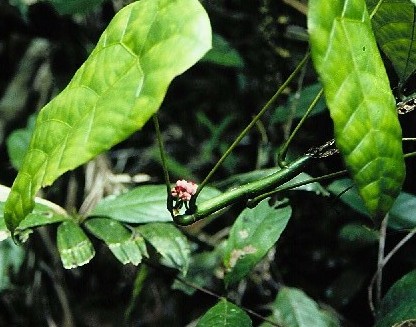Macaranga caladiifolia Becc.
Shrubs to small trees up to ca. 6 m tall and 24 cm dbh, reproductive from 1.5 m tall and 2 cm dbh. Twigs hollow, usually conspicuously swollen, hollow (swollen) internodes irregularly intermixed with narrow solid ones, ant inhabited, glabrous, ant openings large (ca. 2-3 mm diameter), often twigs also splitting (lengthwise) open by themselves. Stipules triangular, early caduceus to semi-persistent, stipules spreading, 7-10 mm long by 3-4 mm wide. Petioles glabrous, up to 25 cm long. Leaves alternate, ovate, peltate, 13-33 cm long by 6-18 mm wide, length/width-ratio 1.75-2.72; secondary veins 7-10, arising almost perpendicular from midrib, ending in the margin; leaf base rounded to truncate, peltate margin length 2-8 cm; leaf margin with conspicuous glands, usually serrate; leaf upper surface glabrous; leaf lower surface glabrous to hairy on veins, often glaucous, numerously gland dotted. Staminate inflorescences branched; flowers clustered per bracteole; bracteole margins entire to wavy. Pistillate inflorescences not branched; fruits ca. 10 mm wide, 3-locular, two distinct glandular patches on each carpel wall.
Ecology: Collected up to ca. 500 m altitude. A shade-tolerant understorey treelet in heath (kerangas) forest and slightly wetter (kerapah) forest over nutrient-poor acidic sandy soils.
Distribution: Endemic for Borneo, where it has been collected in Sarawak and West-Kalimantan.
